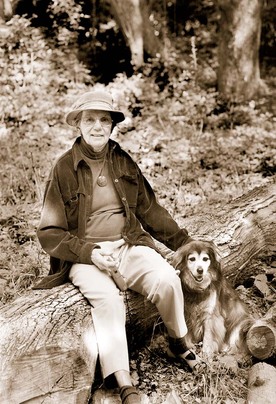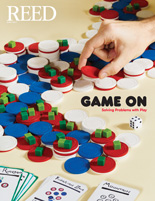
IRIS login | Reed College home Volume 96, No. 2: June 2017
Bio Prof Bequeaths Fortune to Reed
 When President Colin Diver announced last week that Reed's Centennial Campaign had passed the $185 million mark, he also revealed that the late Helen Stafford [biology 1954-87] had bequeathed an astonishing $8 million to Reed in her will. The bulk of the gift will provide financial aid to students otherwise unable to attend Reed, and $1 million will support the biology department.
When President Colin Diver announced last week that Reed's Centennial Campaign had passed the $185 million mark, he also revealed that the late Helen Stafford [biology 1954-87] had bequeathed an astonishing $8 million to Reed in her will. The bulk of the gift will provide financial aid to students otherwise unable to attend Reed, and $1 million will support the biology department.
When news of Prof. Stafford's gift reached her niece Anne Scarff in Amherst, Massachusetts, she was gobsmacked.
"We received a magnanimously generous gift from your aunt this week," we told her.
"Oh, no kidding," she said. "What was that?"
"Her estate has provided a gift to Reed in excess of $8 million."
"I'm sorry. I'm confused. Whose estate?"
"Helen's."
"Helen Stafford's??!!! Eight million? Wow! ... I'm flabbergasted. I knew that Reed would inherit what she had. That was always understood. But I had no idea."
Born in 1922 to a wealthy Philadelphia mill owner and his wife, Helen was raised in a big house with servants. But when the stock market crashed in 1929, Milton Stafford lost his fortune and Helen attended Wellesley on scholarship, working her way through college.
Her distinguished career began when Helen studied botany with geneticist Harriett Creighton at Wellesley. She worked as a research assistant at Cornell, then took a research position with Richard Goodwin at Connecticut College for Women. Goodwin persuaded the college to create a master's degree for Helen's groundbreaking thesis about the development of anatomical structures and the effect of light in timothy grass seedlings. The thesis was published in the American Journal of Botany, the first of her more than 70 publications.
Dr. Robert McNair Scott '61 met Helen when she was studying with David Goddard at the University of Pennsylvania. She had overcome prejudice to become the first woman to teach male botany students at the university and earned a PhD in 1951 for her discoveries about plant enzymes.
"When I was considering Reed," Robert remembers, "my mother said that David considered Helen Stafford one of his finest students. That was one of the things that drew me to Reed."
During his sophomore year, Robert worked for Helen as a teaching lab assistant.
"I learned more from her patient and enlightened teaching that year than I did in class," he said. "Helen was a quiet but inspiring person and a very fine teacher. She was an incredible woman who opened many doors, both to her students and to her gender."
It was while she was teaching at the University of Chicago that she came to the attention of Reed's biology faculty, and in particular Lewis Kleinholz [1946-1980] who recognized that the department would benefit from her exemplary teaching and research experience as well as her reputation for clear, thoughtful, innovative work.
In 1954, Helen accepted a position as Reed's sole biology professor specializing in botany and the only female faculty member in the sciences. She and her colleagues laid the groundwork for what became one of the top undergraduate biology programs in the U.S.
"Helen was very active in what we were trying to accomplish, which was to change the whole department and its approach to teaching," says Laurens Ruben [biology 1955-92]. "Most of our students were going on to graduate work and the program we were offering didn't create enough depth and or take sufficient advantage of scientific inquiry. We tried to take the best things of a graduate program and meld them with the best things of an undergraduate program."
Anne Wood Squier '60 taught labs for the biology department and worked for Helen one summer.
"Nothing got in the way of the absolute precision of her experimental methods and she had a passion for new knowledge," Anne says. "She found her niche at Reed where she could teach bright students, and get a lot of satisfaction from pointing them down various pathways, and continue to do her work at a very high level."
Anne and her husband, Professor Leslie Squier [psychology 1955-88], lived at the top of the canyon and often saw Helen walk past their driveway "first with Willie, a beautiful little sheltie, and then after he aged out with each dog that succeeded him."
An automobile hit Willie, remembers Bert Brehm [biology 1962-93], and the dog limped around with his leg in a cast. "Years later, whenever Helen chastised the dog, Willie would limp in a bid for sympathy. Late in his life, Willie would forget which leg had actually been injured and variously, limped on different legs."
Helen served as a role model both for the women who took her classes and those that followed her into the department as faculty.
"We all knew she was exceptional," says Pamela Ronald '82. "At that time there were still very few women scientists, at least very few highly recognized scientists. She was the only woman in the department. So she was definitely a pioneer and we were really glad about that. We figured if she could do it well then why couldn't we? Having women mentors meant a lot to us."
Currently a professor of plant pathology at the University of California-Davis, Pamela remembers that Helen was both very reserved and focused.
"But Helen was inspirational because she loved her work, and was interested in what her students were thinking about. She was one of those professors who really gripped my imagination and made me believe in the power of the individual, that one person can make a difference."
Living frugally, Helen endowed the $1 million Morton O. Stafford Jr. scholarship at Reed in memory of her brother, who was killed in World War II. She savored her work and continued to advise thesis students four years after she retired from teaching at Reed in 1987.
Rae Gitzendanner '96 looked forward to her weekly meetings with Helen.
"She spoke with such passion. Discussing this thesis with someone as knowledgeable, enthusiastic and patient as Helen was definitely an unexpected reward. She provided an open and lively atmosphere where we could test out ideas."
Now an environmental engineer in Gainesville, Florida, Rae had three areas in her thesis and while two were progressing, one floundered. Helen felt it was important that Rae enjoy her thesis experience and suggested they change the thesis goals. That which was not moving forward could be left behind and Rae would still learn from the other areas.
"She felt the important thing was to pursue what most interests and excites you--to pursue one's strengths rather than continue to focus on one's weaknesses," Rae says.
In addition to being awarded a Guggenheim Fellowship at Harvard, an NSF senior postdoctoral fellowship at UCLA, and work on condensed tannins at the Oregon Graduate Center, Helen consistently broke new ground with her work on aromatic compounds, flavonoids, proanthocyanidins, and the particular compound plants used for defensive purposes and to make structural materials.
Some years after retiring from teaching, Helen was diagnosed with Alzheimer's.
"The transition to Alzheimer's was obviously very difficult, but she did it with that typical curiosity that she always had," her niece, Anne, remembers. "She wanted to understand it and do what she could. I think she maintained that fine sense of curiosity right through this transition of immense loss intellectually."
Mary Potts, who was employed as Helen's caretaker for six and a half years, remembers visiting Reed's campus with Helen and her faithful dog, Brownie.
"Reed was her life," says Mary, "she just loved it and came in five days a week with Brownie to walk around campus. Helen never left the house without two things, her hat and Brownie. So many kids on campus knew Brownie by sight. They'd say 'Hi, Brownie,' and these were kids she hadn't taught because by the time I got there she hadn't been teaching for some time.
"We used to go to the college to collect her biology magazines. Physically the disease progresses little by little. Finally she told the secretary in the department not to set the magazines aside for her anymore, because she couldn't comprehend what she was reading. She wanted to make sure that if they ever found something that would slow down the disease that she would take it. But that didn't really happen."
Helen's legacy of scholarship, both as a teacher and in providing opportunities for future students to become Reedies, insures she will be remembered.
"Reed was everything to her," Anne says. "I'm so delighted that she will be a part of Reed's future; I just couldn't be happier. I almost wish it was known in her lifetime so she could enjoy some of the celebration. But that wasn't like her, she wasn't one to do that."
Following her wishes, Helen's ashes were scattered on the shore of Reed Lake near the blue bridge that she loved.
Tags: Helen Stafford


LATEST COMMENTS
steve-jobs-1976 I knew Steve Jobs when he was on the second floor of Quincy. (Fall...
Utnapishtim - 2 weeks ago
Prof. Mason Drukman [political science 1964–70] This is gold, pure gold. God bless, Prof. Drukman.
puredog - 1 month ago
virginia-davis-1965 Such a good friend & compatriot in the day of Satyricon...
czarchasm - 4 months ago
John Peara Baba 1990 John died of a broken heart from losing his mom and then his...
kodachrome - 7 months ago
Carol Sawyer 1962 Who wrote this obit? I'm writing something about Carol Sawyer...
MsLaurie Pepper - 8 months ago
William W. Wissman MAT 1969 ...and THREE sisters. Sabra, the oldest, Mary, the middle, and...
riclf - 10 months ago